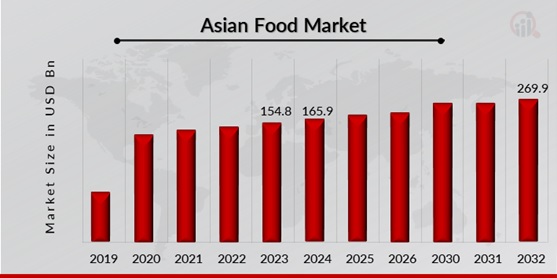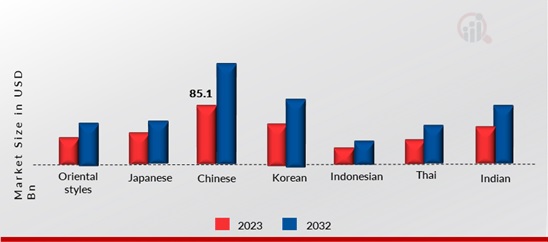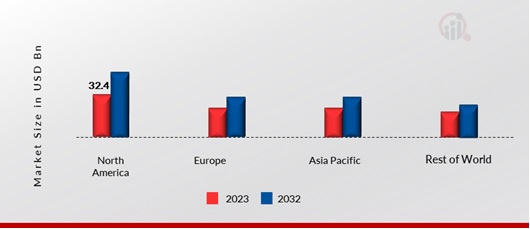Global Asian Food Market Overview
Asian Food Market Size was valued at USD 154.8 Billion in 2023. The asian food industry is projected to grow from USD 165.9 Billion in 2024 to USD 269.9 Billion by 2032, exhibiting a compound annual growth rate (CAGR) of 7.20% during the forecast period (2024 - 2032). Rising health awareness and culinary tourism are the key market drivers enhancing the market growth.

Source: Secondary Research, Primary Research, MRFR Database and Analyst Review
Asian Food Market Trends
-
Rising health consciousness drives market growth
The rising health awareness is a major driver that drives market CAGR for Asian Food. Consumers are increasingly prioritizing health and wellness, resulting in increased demand for Asian cuisine, which is noted for its fresh ingredients, balanced cooking methods, and emphasis on veggies. This tendency is consistent with the notion of Asian food as healthy and good for general well-being. As a result, firms in the Asian food sector are adjusting by providing better menu alternatives, emphasizing the health advantages of their meals, and meeting the increased demand for nutritious food options. The emphasis on health-conscious consumers has not only fueled market expansion but has also promoted industry innovation, with the introduction of new, healthier Asian cuisine items and concepts to satisfy the changing demands of health-conscious customers.
Innovation in Asian cuisine, including developing new dishes, cooking techniques, and food products to meet changing consumer preferences and trends, is also driving the market growth. Fusion cuisine combines traditional Asian flavors with local products or cooking ways to create distinct and fascinating culinary experiences. This trend appeals to a varied consumer base looking for innovative and experimental cuisine options. The fusion of Asian flavors with other cuisines has not only increased market reach but also stimulated inventiveness and excitement among foodies. Businesses that incorporate innovation and fusion into their products are well-positioned to catch the attention of consumers seeking different and new dining experiences, eventually driving growth in the dynamic Asian food sector.
Moreover, globalization is a fundamental driver of growth in the Asian food business. Globalization has fostered the spread of Asian food over the world, resulting in a greater appreciation for its various flavors and culinary traditions. As individuals grow more interconnected through travel, social media, and worldwide trade, demand for Asian cuisine has increased. This tendency has created new markets for Asian culinary products and restaurants, resulting in increased industry growth and profitability. Furthermore, cross-border exchanges of culinary ideas and techniques have spurred Asian cuisine's inventiveness and ingenuity, increasing its popularity. Embracing globalization enables Asian food enterprises to reach a larger audience and adapt to various consumer demands, ultimately contributing to the Asian food market's ongoing expansion and evolution globally. Thus driving the Asian Food Market revenue.
Asian Food Market Segment Insights
Asian Food Product Insights
The Asian Food Market segmentation, based on Product, includes Oriental styles, Japanese, Chinese, Korean, Indonesian, Thai And Indian. Chinese category has the greatest market share in the Asian food market and is likely to maintain its dominance during the projection period. Asian meals include Chinese, Thai, and Indian cuisine. It has been immensely popular in the nutrient segment in Western countries since it is thought to be more nutritious than traditional foods such as burgers, pizza, pasta, burritos, tacos, and sandwiches. The market is highly fragmented internationally, with many tiny businesses operating as exclusive or chained restaurants.
Figure 1: Asian Food Market, By Product, 2023 & 2032 (USD Billion)

Source: Secondary Research, Primary Research, MRFR Database and Analyst Review
Asian Food Regional Insights
By region, the study provides the market insights into North America, Europe, Asia-Pacific and the Rest of the World. North America has the highest revenue share in the Asian Food global market. This supremacy can be due to North America's diversified populace, which values and enjoys Asian cuisine. The region has a strong desire for real Asian cuisine products, resulting in a vibrant market for sushi, ramen, curry, and boba tea. Furthermore, the presence of several Asian restaurants, grocery stores, and food delivery services in North America contributes significantly to the Asian food market's revenue. The popularity of Asian cuisine, combined with the expanding trend of fusion meals, has catapulted North America to the top revenue share in the global market for Asian food goods.
Further, the major countries studied in the market report are the US, Canada, German, France, the UK, Italy, Spain, China, Japan, India, Australia, South Korea, and Brazil.
Figure 2: ASIAN FOOD MARKET SHARE BY REGION 2023 (USD Billion)

Source: Secondary Research, Primary Research, MRFR Database and Analyst Review
Europe Asian Food Market accounts for the second-largest market share. This is due to spicy food with varied sauces being in high demand across Europe. Further, the German Asian Food industry held the largest market share, and the Market of UK Asian Food was the fastest-growing market in the European region.
The Asia-Pacific Asian Food Market is expected to grow at the fastest CAGR from 2024 to 2032. The region's rich culinary heritage and varied spectrum of Asian cuisines are fueling this rapid expansion. With a vast population that enjoys and consumes Asian food on a regular basis, demand for authentic Asian ingredients, recipes, and flavors is increasing across the Asia-Pacific region. Moreover, China’s Asian Food Industry held the largest market share, and the Indian Asian Food Market was the fastest-growing market in the Asia-Pacific region.
Asian Food Key Market Players & Competitive Insights
Leading market players are investing heavily in research and development in order to expand their product lines, which will help the Asian Food Market, grow even more. Market participants are also undertaking a variety of strategic activities to expand their global footprint, with important market developments including new Product launches, contractual agreements, mergers and acquisitions, higher investments, and collaboration with other organizations. To expand and survive in a more competitive and rising market climate, Asian Food industry must offer cost-effective items.
Manufacturing locally to minimize operational costs is one of the key business tactics used by manufacturers in the global Asian Food industry to benefit clients and increase the market sector. In recent years, the Asian Food industry has offered some of the most significant advantages to medicine. Major players in the Asian Food Market, including Pei Wei Asian Diner, Panda Express, Moods Hospitality Pvt. Ltd., Inns’ Bruck, and Eurofood Group Plc. and others, are attempting to increase market demand by investing in research and development operations.
Panda Express is a fast-food restaurant chain that serves American Chinese cuisine. With approximately 2,200 locations, it is the largest Asian-segment restaurant chain in the United States, where it was started and is mostly concentrated in North America and Asia. Panda Express restaurants were traditionally found in shopping mall food courts, but the brand now operates in a variety of settings and formats, including stand-alone restaurants, universities, casinos, airports, military bases, amusement parks, and other locations. In August 2022, Panda Express opened its first European location in the Kaiserslautern Military Community Centre food court at Ramstein Air Base in Germany.
Pei Wei Asian Diner, LLC is an American restaurant franchise that serves Pan Asian cuisine with 119 locations in the United States. Pei Wei's dishes are prepared to order in an open-concept kitchen using cooking techniques such as wok firing. The restaurant provides guest customization, including vegetarian and gluten-free alternatives. In December 2019, Pei Wei declared its independence from the parent firm, P.F. Chang's China Bistro. This separation would result in a small name change and the relocation of the company's headquarters from Scottsdale to Irving, Texas.
Key Companies in the Asian Food Market include
- Pei Wei Asian Diner
- Panda Express
- Moods Hospitality Pvt. Ltd.
- Inns’ Bruck
- Eurofood Group Plc.
Asian Food Industry Developments
In 2024, Kikkoman launched a new soy sauce specifically formulated for sushi and sashimi. This product is designed to enhance the delicate flavors of sushi and sashimi with a balanced, less salty profile.
In 2024, Annie Chun’s released a variety pack of Korean BBQ sauces, featuring new flavors like Spicy Gochujang and Sweet Soy Glaze. This pack aims to offer a range of options for different Korean BBQ dishes.
Asian Food Market Segmentation
Asian Food By Product Outlook
- Oriental styles
- Japanese
- Chinese
- Korean
- Indonesian
- Thai
- Indian
Asian Food Regional Outlook
- North America
- Europe
- Germany
- France
- UK
- Italy
- Spain
- Rest of Europe
- Asia-Pacific
- China
- Japan
- India
- Australia
- South Korea
- Australia
- Rest of Asia-Pacific
- Rest of the World
- Middle East
- Africa
- Latin America
| Report Attribute/Metric |
Details |
| Market Size 2023 |
USD 154.8 Billion |
| Market Size 2024 |
USD 165.9 Billion |
| Market Size 2032 |
USD 269.9 Billion |
| Compound Annual Growth Rate (CAGR) |
7.20% (2024-2032) |
| Base Year |
2023 |
| Market Forecast Period |
2024-2032 |
| Historical Data |
2019- 2021 |
| Market Forecast Units |
Value (USD Billion) |
| Report Coverage |
Revenue Forecast, Market Competitive Landscape, Growth Factors, and Trends |
| Segments Covered |
Product and Region |
| Geographies Covered |
North America, Europe, Asia Pacific, and the Rest of the World |
| Countries Covered |
The US, Canada, German, France, UK, Italy, Spain, China, Japan, India, Australia, South Korea, and Brazil |
| Key Companies Profiled |
Pei Wei Asian Diner, Panda Express, Moods Hospitality Pvt. Ltd., Inns’ Bruck, and Eurofood Group Plc. |
| Key Market Opportunities |
Increasing Globalization |
| Key Market Dynamics |
Rising Health Consciousness |
Frequently Asked Questions (FAQ) :
The Asian Food Market size was valued at USD 154.8 Billion in 2023.
The global market is projected to grow at a CAGR of 7.20% from 2024 to 2032.
North America had the largest share of the global market.
The key players in the market are Pei Wei Asian Diner, Panda Express, Moods Hospitality Pvt. Ltd., Inns’ Bruck, and Eurofood Group Plc.
The Chinese category dominated the market in 2023.

















